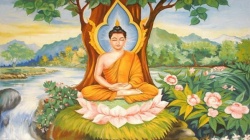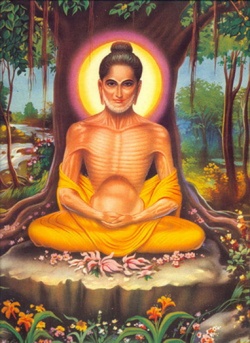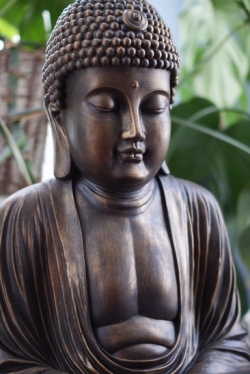Buddhism, common misconceptions about Buddhism
Buddhism was known in the West many decades before its sacred scriptures were fully translated into Western languages and before the differences between early Buddhism (i.e. Theravāda), Mahāyāna and Vajrayāna were understood. Some of the earliest Westerners to write about Buddhism were Christian missionaries who studied it as a part of their agenda of
replacing it with their own beliefs. Even the missionaries who tried to write about Buddhism objectively, and some did, often saw its doctrines through their own conditioning and assumptions. The first Westerners who were, or better, who thought of themselves as Buddhists, were in fact often Theosophists. These people were usually not
scholars and thus often confused Buddhism with Hinduism or with their own ‘esoteric’ beliefs. Today, despite the availability of good Books on Buddhism and the translation of the Tipiṭaka, some of the misunderstandings about
Buddhism have gone into popular consciousness and are taken for granted. Others are a result of mistaking Buddhism with various New Age beliefs. Some of these misunderstandings and confusions are serious, others only minor. Below is a collection of the more common ones.
The Buddha was a rationalist and did not teach Rebirth or reincarnation, an idea that was added to his teachings in later centuries.
The Doctrine of Rebirth is an integral part of Buddhism and fits seamlessly with all the other central teachings of The Buddha. There is no evidence - textural, historical or linguistic - which suggests that the passages in the Tipitaka that discuss Rebirth were added later. See Rebirth.
Not a drop of blood has ever been shed in the name of Buddhism.
As nice as this would be if it were so, it is not true. History shows that Buddhist monarch have occasionally used Buddhism as an excuse to invade other countries, that they have also occasionally suppressed other faiths or sects of Buddhism, and that their aggressiveness has sometimes been endorses by Buddhist leaders. However, it is true that while political warfare his been as
common in Buddhist lands as it has been elsewhere, religious wars and persecution of other religions and dissenting sects of Buddhism has not been common. Compared to the major theistic religions Buddhism has generally been a tolerant religion. See Tolerance and War.
Buddhism teaches that at death the soul passes from one Body to the next.
All Buddhists sects teach that there is no eternal unchanging soul or Atman. This is one of the most unique and characteristic teachings of Buddhism. See Anattā, Anattā and rebirth, Rebirth and Self.
The Buddha copied the idea of Rebirth or reincarnation from Hinduism.
This misunderstanding even makes it into academic works. As it is such a widely accepted notion we will examine it in detail. The idea of Rebirth or reincarnation became current in Hinduism but it was not a central teaching of
Brahmanism, the prevailing religion at the time of The Buddha. The Vedas, the most ancient and authoritative Hindu scriptures make no mention of Rebirth. Indeed they contain only a few vague references to any post-mortem state. The Brahmama Sāstras likewise make no reference to Rebirth. Of the Upanisads that pre-date The Buddha (dating
is very uncertain) a wide variety of after-life theories are presented. The Brhadāranyaka says “the Karma of he who reveres the Atman as the world does not die and out of this Atman he creates whatever he likes after death” (1.4.15). This could allow for the possibility of Rebirth but it is only implied. Brhadāranyaka 5.6.1 says that after death one goes to the
wind, the sun, the moon or to a world that is without heat or cold. The Chāndogya says that the dead attain company with the sun (3.17.6.7). The Taittirīya Upanisad teaches that “after departing from this world his self becomes food…the life-principle...the mind…understanding…or bliss” (3.10.5). Likewise neither Yājṭavalkya, Uddālaka or
Prajāpati discuss Rebirth. So the claim that Rebirth or reincarnation was universally accepted in pre-Buddhist Indian religion is not supported by the evidence. The first mention of the idea in the Upanisads is in the Katha Upanisad (1.2.6 and 2.2.7). From then on it seems to have become gradually accepted. However, the
exact date of the Katha is by no means certain, although scholars generally place it before The Buddha or contemporary with him. Whatever the case, judging from the literature, Rebirth or reincarnation was not a widely held belief prior to The Buddha. The only thing that can be said with certainty is that Jainism pre-dated Buddhism and certainly did teach
Rebirth, although a significantly different version from the Buddhist theory. See Brahmanism, Hinduism, Vedas, Rebirth and Reincarnation.
Buddhism is a form of Hinduism or started as a reform movement within Hinduism. See Brahmanism, Caste, Hinduism, Illusion and Vedas.
The Dalai Lama is the head of Buddhism. There is no single Buddhist ‘church’ any more than there is in [[Wikipedia:Christianity|Christianity]], Judaism, Islam
or Hinduism. Even within individual Buddhist countries the monastic Sangha and sometimes the lay community too, are divided into different sects, each with their own head or leader. The Dalai Lama is looked up to by the
people of Tibet as their political leader and he has great moral authority within the sects of Tibetan Buddhism, but he not a leader of any one of them, let alone of any Buddhist sects in other countries. See Dalai Lāma
The Buddha is a god or The Buddha taught that there is a God.
The Buddha was enlightened while sitting under a banyan tree.
The Bodhi tree (Pāḷi asattha, botanical name Ficus religiosa) and the banyan (Pāḷi nigrodha, botanical name
Ficus bengalisa) are two quite distinct trees and can be easily distinguished even by the casual observer. The leaves of the Bodhi are thin, light green and have a distinct point, while banyan leaves are thick, dark green and
elliptical in shape. The most notable difference is that the banyan has aerial roots coming from its branches which grow into trunks that support the ever-spreading boughs, while Bodhi trees have no aerial roots. See Bodhi tree.
The Buddha was a vegetarian and all good Buddhists should be vegetarian.
Nirvāna is to become one with everything.
This idea is so widespread that it is even the subject of jokes. “A Buddhist went up to a hot dog vendor and said ‘Make me one with everything.’ ” The idea that the goal of Buddhism is to ‘merge into the Absolute’ or to ‘identify with everything’ is neither mentioned or implied in any Buddhist scriptures. This is a concept in several interpretations of Vedantic Hinduism which has been a wrongly attributed to Buddhism.
The Buddha is a big fat laughing guy.
The Buddha has never been depicted as obese or fat, which Buddhists would usually associate with excess, over-eating or greed, the very antithesis of everything Buddhism is about. What people incorrectly call the Laughing Buddha is actually a traditional Chinese amalgam of the semi-legendary character Ch’tz and Maitreya. See Laughing Buddha.
Buddhist are ‘not allowed’ to desire anything. Buddhists are ‘not supposed’ to…Buddhists ‘shouldn’t’…etc.
Statements like these are examples of where the obligatory or compulsory character of theistic religions have been superimposed onto Buddhism. Concerning this first statement, The Buddha nowhere said his disciples are ‘not allowed’ to
desire, which would be laying down an obligation, and would most likely result in people suppressing their desires rather than diminishing them. The Buddha simply pointed out that there is a perceivable relationship between desire and mental
discomfort and Suffering, which is a statement of fact. The person who considers this observation, understands it and decides to do something about it, might well take up Buddhist practice. The Buddha was an educator rather than a lawgiver.
Meditation is a form of Escapism.
This idea is probably derived from the belief that the purpose of meditation is to induce some form of trance. Trance states have no role in Buddhist meditation, the main idea of which is to develop concentration and Mindfulness.
With concentration the ability to be focused and attentive is enhanced which has many benefits, including being able to function better in daily life. Mindfulness (or awareness) brings with it an alertness of what is happening around one and
within one. This includes a better understanding of the positive and negative traits and habits that together make up one’s personality. Thus rather than being a form of escapism meditation helps us actually see and then constructively deal with reality. See Meditation and Mindfulness.
Buddhists consider it rude to point your feet at a Buddha statue or a Monk, or to touch someone on the head.
These and many similar ideas are examples of where the etiquette or customs of one particular Buddhist culture are attributed to Buddhism or to all Buddhist cultures. A similarly misleading equivalent would be to say “Christians
eat spaghetti” because spaghetti is widely eaten in Italy and most Italians are Christian. The behaviors mentioned above are considered impolite in Thailand but not so by Buddhists in Sri Lanka, Ladakh, Korea, China,
Japan, etc. Cultural practices are one thing, Dhamma is another and the two should not be confused. Likewise, the cultural norms of one Buddhist country may well differ from those of another Buddhist country, just as they do in other religions.
According to Buddhism nothing really exists, everything is an illusion. See Illusion.
During Jesus’ ‘lost years’ he went to India and studied Buddhism.
This claim was first made in a book by the otherwise obscure Russian journalist Nicolas Notvitch in 1894 and was quickly and convincingly debunked by scholars. The so-called Gospel of Issu which Notvitch claims to have discovered and translated has never
been found and the monastery he claims Jesus studied in and where records of him were kept, Hemis, was not established until 1672. In the 1960s the story was revived and has since become almost ‘gospel’ amongst proponents of New Age thinking and even in some otherwise intelligent circles. No accredited scholars or historians takes this story seriously.
There are no ‘lost years’ in Jesus’ life. Until he started preaching at the age of about 30 little was recorded about him simply because he did little to attract public attention. Obscure carpenters rarely make it into the historical records. The fact that
merchants from the eastern Roman Empire sometimes traveled to India is not proof that Jesus went there and there is no evidence that he ever did. Because we know almost nothing about the first decades of Shakespeare’s life is not proof that he spent these ‘lost years’ in America or China.
The most solid evidence that Jesus never studied Buddhism is that none of the essential and characteristic doctrines of The Buddha’s Dhamma are found in or even hinted at in Jesus’ teachings. His gospel can, on the
other hand, be seen as a continuation of or a development of traditional Jewish belief and practices. Jesus frequently quotes from or alludes to sayings in the Old Testament. He never once quotes from the Buddhist scriptures.
Perhaps in response to or to counter the ‘Jesus went to India’ myth some evangelical missionaries in Asia have began claiming that there was a prophecy in the Buddhist scriptures about the coming of Jesus but it was removed during
the Sixth Buddhist Council in 1956. Copies of the Buddhist scriptures written centuries before 1956 exist in large numbers and
none of them contain anything like a prophecy about Jesus. While the ‘Jesus went to India’ story is a harmless fantasy, the ‘Buddha prophesized the advent of Jesus’ claim has probably been concocted as a part of a missionary strategy win converts amongst Buddhists. See Buddha and Jesus
The Buddha sat so still for so long that snails crawled all over his head. That’s why he has those spiral-like nodule on his head instead of hair.
And one of them flew over the cuckoo’s nest!
It would be more correct to say that The Buddha was born ‘in what is now Nepal’ the present state of Nepal only having come into existence in the mid 18th century. More correct still would be to say that The Buddha was born in India, not India as a modern political entity but India as a cultural unit.


